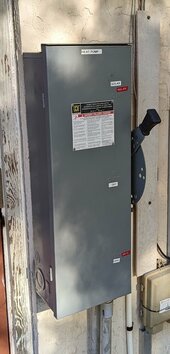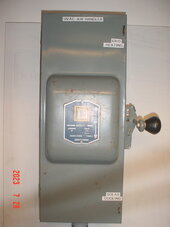OK, long food for thought for someone new to this
As noted above... the first question to answer is whether you plan to get a 'connection agreement' with your local provider (Power Company/ PoCo), or not. The answer to that question will determine most of what will follow.
In general, if you chose NOT to go the route of connection agreement (whose difficulty and expense varies by location) then safety, and all kinds of other reasons, that if you get solar or a battery, you need to make sure it is NOT possible (even with end-user mis-configuration of an inverter) to send power onto the grid. And doing so properly can get complicated in older residential suburban construction (or wherever)... do NOT trust lower-cost, less mature solution firmware claiming Zero export, without doing you due diligence on how reliable that is, how well it handles end-user 'oopses' and what PoCo response is to even momentary backfeeding onto grid without permission
So with that out of the way...
- A typical hybrid inverter is capable of grid-forming (ie, run local power with battery and/or solar) when grid power is down. In a grid-down scenario, you have to either manually, or planned in advance, which circuits you have enough 'juice' (kW, in this case) to run your electrical loads. Some people go the route of critical loads panel to not power entire house, but only select circuits when grid goes down. However, depending on your specific house wiring that may or may not be easy/inexpensive.
if you plan the non-permit/ no agreement route (ie off-grid), then the safe approach is to have complete separate circuits. Powering A/C by solar in this scenario isn't a thing, unless A/C on own circuit. And then it ONLY works when there is sufficient solar power, and if not careful, you could damage equipment when power is almost, but not quite enough especially if bouncing between thresholds such as cloud goes over. No A/C from a bit before sunset until a bit after sunrise. Unless you have transfer switch to cut A/C off its connection to solar to grid power (ie change which circuit its connected to... don't ignore cost to set up such wiring).
BUT the EG4 can the power switch automatically... and it can power any/all loads connected to it (within system limits), and can mix solar and grid power... which is typically what you want... use all solar to reduce bill. If adding a battery, then depends on whether you have Time-of-Use rates or not, and your priority as to whether to maximize self-consumption (ie using solar power vs from grid) or battery backup (ie, keep battery at/near 100% all the time in case of grid-outage).. That is up to you, but your outages tend to be storm related, which you will know about in plenty of time to change setting and fill batteries 'just in case', so leaving the inverter/batteries in such a max for outage scenario is not usually necessary/recommended... but, is up to you
So, when you cay use solar to power A/C, and grid for rest of house, that typically means (to those not new around here) that you mean separate circuits and an off-grid setup. But, you comment suggests to me that is NOT what you are looking for. Sounds like you are looking for a properly permitted inter-connection setup. In which case, the first place to start is to analyze your current electricity consumption, and then go from there.
- Beware, modern hybrid inverters are relatively new, and an uncertain lifespan. And lifespan will depend, in part.. I think, based on whether using DC string inverter built in vs AC coupling micro-inverter connected PV panels.. Pro's and Con's to AC vs DC connected panels... [I'd steer very clear of anyone who tells you there is only 1 right way to do it... they are clueless].
As such, a switch to bypass the hybrid inverter if/when it fails, is a good idea. Personally, I think the safer approach is consider hybrid inverter like a water heater.. outwardly looks great right up until it isn't. Do not expect same day service/repair. As neither I nor my family would appreciate a multi-day power outage due to a failed hybrid Inverter (possibly require electrician emergency visit to manually re-wire/bypass), a simple way to bypass the Inverter myself seems more than prudent ... just a suggestion
- The reason for figuring out your current usage is that with purchase and installation expense and wiring involved (especially if you aren't someone with professional electrician knowledge), upgrading hybrid Inverter is NOT something you want to do with any frequency. So you need to understand your peak electrical loads, common heavy load state, and any planned significant electrical load changes (like going from ICE to EV, or cutting over natural gas to electrical appliances (if such applies to you)... And then what electrical circuits you are OK with NOT being powered in a grid-down situation
That will dictate the size inverter you need. For ex.. an EG4 12k would only be 'ok' for me, as I have all natural gas appliances, and low A/C usage or other heavy electrical loads. with low background loads (frig and misc others) EVSE at 16A and brand new heat pump Air Conditioner for only part of house... I'm pulling 30A, or a little more. So, for me, the 12K or any other devices only support 7-8kW continuous just doesn't give me ANY headroom for future electrification (which I expect)... I share that thought process/analysis to give you something to think about. I have family in TX, and their electrical usage is 3-4X mine, so something to consider.
For me, critical circuit panel makes no sense, as I have limited high kW draw circuits, and both of them remotely controllable, so if grid down, I can directly control them easily ... so why both with critical load panel? just power whole house by hybrid inverter ... but I recognize that is my situation, and ymmv. And in some case, some home automation to turn off system/circuits when grid-down may be easier/cheaper than setting up a critical loads panel and re-wiring
As for gradually expanding/scaling up
- recognize that if roof-mounting PV panels, most contractors won't come back to add a couple panels at a time. IF you have experience or friend who can work on roof, not damage anything, and add panels... then great... but for professionally installed roof panels, such expansion is uncommon/infrequent/rare (yes people expand, but it is a major undertaking, not something done incrementally...
again, not referring to DIY setups ... though even then, wiring, mounting systems, etc... gradually adding panels is not something one reads about (that I've seen)
- mentioned hybrid inverter sizing above
- Yes, people do add batteries over time (especially with new chemistries/technology and improving batter performance...).. but mixing battery tech over longer periods of time can be complicated to do safely and properly.. potentially major risk if done wrong.. it depends.
Best wishes to enjoying the solar journey




